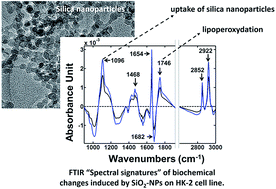Monitoring biological effects of 20 nm versus 100 nm silica nanoparticles induced on a human renal cell line using Fourier transform infrared spectroscopy
Abstract
Due to their small size, nanoparticles (NPs) and particularly silica NPs (SiO2-NPs) exhibit unique properties that confer them especially great biological reactivity. Thus, intensive research studies are performed to elucidate their potential toxicity and/or their interaction with biological systems. Standard assays focus on one specific biological event which require the use of several tests to determine all potential effects induced by SiO2-NPs. Moreover, because of the interaction between the reagent and SiO2-NPs, the reliability of colorimetric or fluorometric methods is questioned when assessing nanomaterials. Therefore, Fourier transform infrared (FTIR) spectroscopy was used as a reagent-free and time-saving tool, combined with Principal Component Analysis (PCA), to reveal biochemical effects induced by 100 nm versus 20 nm SiO2-NPs on human kidney cells (HK-2) at two subtoxic concentrations (10 and 25 μg ml−1) during 24 h. This technique allows revealing dose-dependent responses and differences in biological effects between 20 nm and 100 nm SiO2-NPs with a greater impact of 20 nm SiO2-NPs. Moreover, SiO2-NP cell uptake has been highlighted. Toxic biochemical effects induced by 20 nm SiO2-NPs are detected as hallmarks of lipid peroxidation (1746 cm−1) and apoptosis (1654, 1746 and 2922 cm−1). This study demonstrates that this technique is more sensitive than cytotoxic assays and may be appropriate as a simple screening tool to quickly monitor cellular biochemical changes induced by NPs.


 Please wait while we load your content...
Please wait while we load your content...